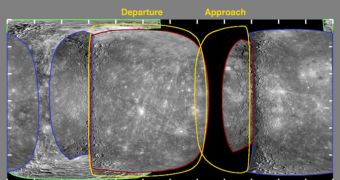In less than a week's time, NASA's Mercury Surface, Space Environment, Geochemistry, and Ranging (MESSENGER) spacecraft will perform its third and final flyby of the planet, as well as its last gravity assist maneuver. This will set it on a course that will enable it to be captured in the planet's orbit in 2011. During the last flyby of the mission, the probe will pass less than 142 miles above the planet, and will image its surface again with all of its instruments, the American space agency reports.
MESSENGER alone has already imaged some 90 percent of Mercury's surface during its previous two flybys, and the next one will complete the most detailed map of the closest planet to the Sun. Specific features on the surface that have not been fully analyzed during the other passes will get a new look, as mission controllers will activate dedicated instruments aboard the space probe.
“This flyby will be our last close look at the equatorial regions of Mercury, and it is our final planetary gravity assist, so it is important for the entire encounter to be executed as planned. As enticing as these flybys have been for discovering some of Mercury's secrets, they are the hors d'oeuvres to the mission's main course – observing Mercury from orbit for an entire year,” the mission's principal investigator, Sean Solomon, from the Carnegie Institution, in Washington DC, says.
“Scans of the planet's comet-like tail will provide important clues regarding the processes that maintain the atmosphere and tail. The Mercury Atmospheric and Surface Composition Spectrometer (MASCS) will give us a snapshot of how the distribution of sodium and calcium vary with solar and planetary conditions. In addition, we will target the north and south polar regions for detailed observations and look for several new atmospheric constituents,” MASCS scientist Noam Izenberg, from the John Hopkins University (JHU) Applied Physics Laboratory (APL), in Laurel, Maryland, adds.
As MESSENGER departs Mercury for the last time, it will take high-resolution images of the planet's southern hemisphere, the team adds. Estimates say that about 1,500 photos of huge scientific value will be taken during the departure stage of the flyby. During the second flight, the probe has made a similar series of images of the planet's northern hemisphere, and scientists want to combine the two, and obtain the first high-res, mosaic image of Mercury that will feature all of its terrain and surface structures.
“We are going to collect high resolution, color images of scientifically interesting targets that we identified from the second flyby. The spectrometer also will make measurements of those targets at the same time,” APL project scientist Ralph McNutt concludes.

 14 DAY TRIAL //
14 DAY TRIAL //